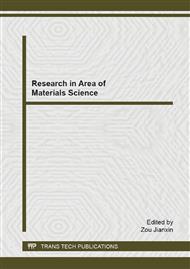[1]
Fina A, Monticelli O, Camino G. POSS-based hybrids by melt/reactive blending. Journal of Materials Chemistry 2010, 20: 9297–9305.
DOI: 10.1039/c0jm00480d
Google Scholar
[2]
Gnanasekaran D, Madhavan K, Reddy BSR. Developments of polyhedral oligomeric silsesquioxanes (POSS) POSS nanocomposites and their applications: a review. Journal of Science & Industrial Research 2009, 68: 437–464.
Google Scholar
[3]
Janowski B, Pielichowski K. Nano-hybrid polymers containing polyhedral oligomeric silsesquioxanes (POSS). Polymer 2008, 53: 87–98.
DOI: 10.14314/polimery.2008.088
Google Scholar
[4]
Kuo SW, Chang FC. POSS related polymer nanocomposites. Progressin Polymer Science 2011, 36: 1649–1696.
DOI: 10.1016/j.progpolymsci.2011.05.002
Google Scholar
[5]
Li GZ, Wang LC, Ni HL, Pittman CU. Polyhedral oligomeric silsesquioxane (POSS) polymers and copolymers: a review. Journal of Inorganic and Organometallic Polymers2001, 11: 123– 154.
Google Scholar
[6]
Pielichowski K, Njuguna J, Janowski B, Pielichowski J. Polyhedral oligomeric silsesquioxanes (POSS)-containing nanohybrid polymers. Advances in Polymer Science 2006, 201: 225–296.
DOI: 10.1007/12_077
Google Scholar
[7]
Tanaka K, Chujo Y. Advanced functional materials based on polyhedral oligomeric silsesquioxane (POSS). Journal of Materials Chemistry 2012, 22: 1733–1746.
DOI: 10.1039/c1jm14231c
Google Scholar
[8]
Wu J, Mather PT. POSS polymers: physical properties and biomaterials applications. Polymer Reviews 2009, 49: 25–63.
DOI: 10.1080/15583720802656237
Google Scholar
[9]
Brown JF. Polycondensation of phenylsilanetriol. Journal of American Chemical Society 1965, 87: 4317–4324.
DOI: 10.1021/ja00947a017
Google Scholar
[10]
Scott DW. Thermal rearrangement of branched-chain methylpolysiloxanes. Journal of American Chemical Society 1946, 68: 356–358.
DOI: 10.1021/ja01207a003
Google Scholar
[11]
Baney RH, Itoh M, Sakakibara A, Suzuki T. Silsesquioxanes. Chemical Reviews1995, 95: 1409–1430.
DOI: 10.1021/cr00037a012
Google Scholar
[12]
Voronkov MG, Lavrentyev VI. Polyhedral oligosilsesquioxanes and their homo derivatives. Topics in Current Chemistry 1982, 102: 199–236.
DOI: 10.1007/3-540-11345-2_12
Google Scholar
[13]
Shao Q. Study on the preparation and property of POSS/PA66 nano-composite fiber]. Shanghai: Donghua University master's graduate degree, (2013).
Google Scholar


